
Literally Hoka One One (pronounced Hoka O-nay O-nay) means "fly over the earth." But that’s not what I’m talking about. I’m asking what Hoka means to the running shoe landscape.
This shoe is a Big Bertha driver. It’s a Prince racket. It’s a parabolic ski. It’s a big idea, elbowing its way in, and when the natural running fad has run its course, and its adherents want to begin again now that their layoffs from running have nominally healed their aching hips, knees, feet, Hoka will be there to baby them back into the lifestyle they love and miss.
I do not give two spits for Hoka, the brand. Or Hoka the company. Or the business. Or the business opportunities. What I do care about is the idea, and the execution of the idea, at least, and in particular, in one Hoka model: the Bondi B. I want to tell you what I think the idea is, because it’s the most revolutionary thing to hit running since the waffle. No. it’s more revolutionary than that.
Two years ago I was talking with Curt Munson, an inspirational, clever mind and voice of technical running. He owns a retail operation in Okemos, Michigan called Playmakers. "You know what I miss?" I asked Curt. "I miss the old Nike Air Mariah, where the heel had a lot of cush, yes, but so did the forefoot. I didn’t feel like I was running in pumps. However, that shoe had no medial support. I was not protected. I’m a 165 pound pronator, not a 125 pound African gazelle sprinting 13-minute 5ks. I want that old Air Mariah, but with structure and guidance."
"I know that shoe," he said. "That shoe exists today. It's an ultra trail running shoe." And there began my love affair with the idea of the Hoka Bondi. Well, sort of. It was the Hoka Mafate, a rather beefy trail version, that I first got. That was an acquired taste. The Bondi came next and, thankfully, not long after I found the Mafate.
The Stinson Evo might be Hoka’s most popular shoe, and I like this shoe. But the Bondi it is not, because it does not provide the tansverse stability that the Bondi offers. You will run properly in the Bondi. For all its pillowlike cushiness, the Bondi is a highly structured shoe and this makes it not only very comfortable, but blisteringly fast. It is the fastest 10oz shoe on the market, by a longshot. This makes it, hands down, the fastest Ironman marathon shoe for most people, because of its raw 5k speed, and because you will not get leg-sore in this shoe while running a 3, 4 or 5 hour marathon.
Let’s talk about midfoot and rearfoot striking for a moment. Some people will trot out imagery demonstrating that everybody strikes heel-first. Yes. True. No doubt, and I never did doubt that. But that’s not the most important truth. The question is, how much pressure is applied to the heel during the strike prior to the runner’s weight landing on the midfoot? It is my contention that, yes, you have true heel strikers, and these runners do compress the heel straightaway. Most are overstriders and that’s why they compress their heels so heavily and early in their footfalls, however, fine, I’ll stipulate to a heel striker’s need to heel strike.
But many of us graze with the heel, move straight to the forefoot, and do our most impactful compressing there. My concerns with high-ramp shoes — shoes where the heel sits 12mm or more above the midfoot — are legion.
First, the heel gets in the way of the most important element of the strike. The heel hits too early. Second, I don’t get a full extension of my calf and achilles. I think this contributes to the “mad calf” disease we middle aged men so often experience. Mad calf is a thing of the past, for me, once I got into Hokas. Third, I don’t mind having cushion in the heel. What I mind is not having it in the forefoot. My request to Asics and Brooks is, go ahead and leave the heels as they are. Just build up the forefoot. Then, if you’re so certain we all need those big heels, fine, anybody who needs that heel has it. But, those who want forefoot cushion are also rewarded.

Yes, those Hokas look huge. But they are not quite as big as they look, because the foot sits down inside, and the midsole is used as a cradle to keep the foot transversely fixed (the foot has no freedom to move side to side). This takes a shoe that is decidedly unsophisticated as regards material and features — no dual density (in fact, very low density), no fancy energy return systems, no medial posting, none of that — and fixes the foot precisely where it needs to be. The shoe is not exactly straight lasted — the inside of the shoe betrays a curve in the arch — but the midsole and outsole on the medial side fills up the arch cut-out you’d usually find in a curve-lasted shoe. This, again, takes a shoe that was made to be a neutral shoe and gives it the transverse support that keeps the foot in place. This shoe is neutral, they say, but it runs right past guidance and right into stability, in the sorts of support an overpronator needs.
The inside of the shoe looks, when you remove the sock liner, like a board or combination lasted shoe. Like a Brooks Adrenaline. Except there is no board. Unlike a moccasin-style construction, the upper is sewn to the outside edge of the midsole, all the way around the edge of the heel, but it’s sewn right to the midsole. To the foam. Weird. Never seen that. But it works.
This is not a shoe review. I’ve already reviewed this shoe. The point here is to note, for posterity, this game changing moment. It’s my chance to someday say, “You read about it here first,” and then to produce the evidence in the form of this article. This shoe is going to change the industry. The only reason it’s not going to do so quicker is because these $700 and $900 million companies are so weary of chasing around minimalism and barefootism that they are likely to say, “We’re done chasing for awhile.”
So, this shoe has some broken field running in front of it, and I doubt it will have any competitors for awhile. It’s going to sneak up on Asics, Nike, Brooks, New Balance, Saucony, Mizuno, because in footwear technical meetings all over America every VP of tech running is showing every COO the exact same shoe, exact same color, with the exact same features, and they’re all discussing how many pairs they can sell at $95, how many at $125, how many at $145.
Meanwhile, some salesman in some tech running footwear retailer somewhere in America is lacing up a Bondi, running up and down the street, and saying to himself.... “Wow.” This happens several times a week. At some point, this will aggregate. “Wow” will become a critical mass.
Hoka One One was bought, recently, by Deckers. Normally, I would be worried. Typically, shoe executives, who would kill to break 40 minutes, are managing tech running companies, and they are always trying to figure out a way to break out into the mass market, where the real money is. These Deckers folks, with brands like Ugg Australia and Teva, are already there. They’re only there. Style, and mass, and volume is what they do. They’re very savvy money makers. Which might make me even more worried.
But these guys are not typical shoe executives. They never had to worry about one day breaking 40 minutes. They've already broken 30, and I’m talking from the CEO on down. True runners — guys with sweat and blood and lactic acid running through their veins — finally got themselves a true, technical, game changing running shoe. Be interesting to see what will do with it.


